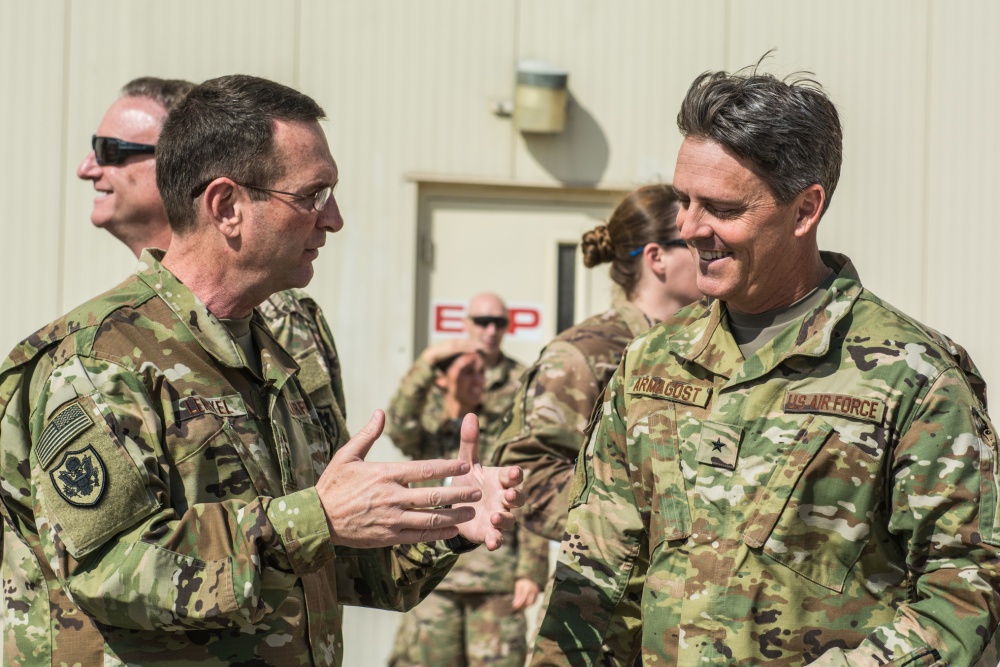
USAF Gen. Joseph Lengyel, Chief of the National Guard Bureau toured around the CENTCOM AOR in early December, visiting Guardsmen supporting Operation Inherent Resolve and Operation Freedom’s Sentinel. USAF photo by SSgt. Patrick Evenson.
The National Guard’s global presence is not as hard to accomplish—or sustain—as it might sound, the service’s boss said at an AFA Mitchell event in Arlington, Va., Thursday. And the Guard’s evolution is the reason why.
A day following its 381st birthday, Gen. Joseph Lengyel said the Guard has changed drastically since he joined in the early 1980s. While it came short in the past in terms of its discipline and focus on doctrine, the Guard has significantly improved in these respects since. Describing the Guard’s full spectrum readiness, Lengyel—who took over as the Guard’s chief in August 2016—said “we’ve become very good” at counterinsurgency.
Therefore, the Guard is better equipped to play a major role in “enabling” readiness for the active components, Lengyel said, adding that guardsmen show up today with “all the same tools and the same skills” as any airman.
“They’ve allowed us to operationally deploy” consistently, and so active component airmen can come back home and reset, train, and later redeploy, Lengyel said.
So what’s the Guard’s global presence mean? Lengyel said he’s got 7,000 airmen and 13,000 soldiers across every combatant command, across every continent. But that “level of exertion that is relatively small,” he added, and so he doesn’t feel stressed. He qualified this by noting there are some stressed career fields, like tanker maintenance. In 2005, he noted, the Guard had 80,000 soldiers and airmen deployed overseas, and at the same time about 50,000 on duty stateside for Hurricane Katrina.
In 2017, the Guard faced a rather unique challenge when a non-stop hurricane season forced it to stretch thin continuously and consistently. Despite the storms’ “devastating damage,” Lengyel said, he lauds the Guard for an “impressive response.”
Another recent and ongoing challenge for the Guard is the ever looming pilot shortage. Lengyel set the service’s shortcoming at “a couple hundred pilots,” adding specifically that “full time pilots is an issue.”
But he said it’s not just about the pilots themselves. “We can’t just add more pilots,” Lengyel explained, without also allowing for the time and resources needed for training. “We just have to be able to fly the sorties.”

Lengyel said Guardsmen show up today with “all the same tools and the same skills” as any airman, speaking at one of AFA’s Mitchell Institute Hour events in Arlington, Va. Staff photo by Gideon Grudo.
Lastly, another major factor forcing the Guard to evolve is the ever changing “security environment.”
“Things were simpler” during the Cold War, Lenyel said. Alliances were clear and “didn’t change very often,” and there was “less competition” and lower risk of alliances breaking and reforming. A stronger Russia and a competitive China weren’t as concerning in the 1990s as they are today. The force shrank to “become more expeditionary” and Americans “felt much safer at home,” Lengyel noted. Oceans that once protected the homeland are now less able to defend against new threats, such as cyber attacks, he said.
“Qualitative military edge is not what it once was,” Lengyel explained, and so USAF needs to reconsider how it “competes” on the world stage, and how it will use the Guard to do so. The global competition—from acquiring resources to establishing Arctic presence to solidifying economic partnerships—he said, is “unlike anything it’s been in the past.”